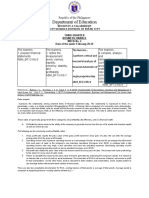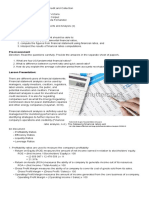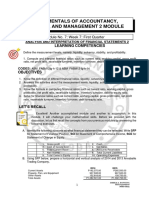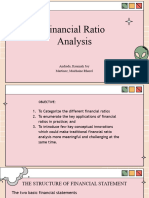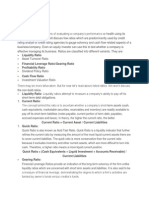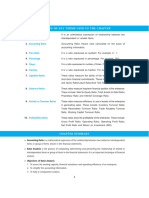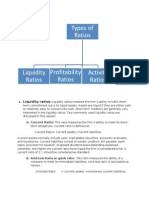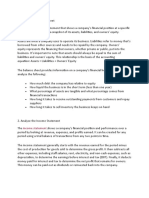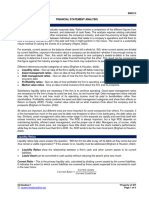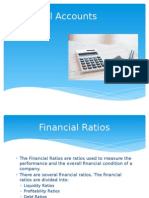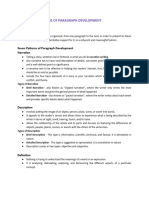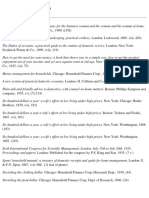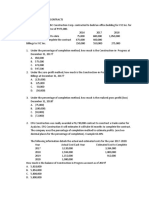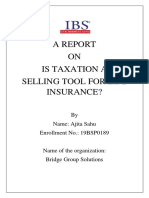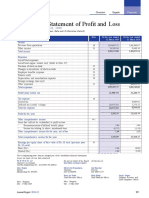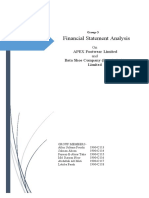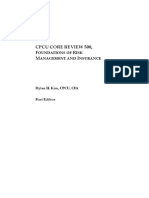ALAMINOS CITY NATIONAL HIGH SCHOOL – SENIOR HIGH SCHOOL DEPARTMENT
LEARNING ACTIVITY SHEET IN FABM 2
I. Title: Financial Statement Analysis Part 2
II. Learning Competency with code.
LC 13. compute and interpret financial ratios such as current ratio, working capital, gross profit ratio, net profit ratio, receivable
turnover, inventory turnover, debt-to-equity ratio, and the like
III. Background Information for Learners
Ratio analysis - expresses the relationship among selected items of financial statement data. The relationship is expressed in terms of
a percentage, a rate, or a simple proportion (Weygandtet.al. 2013). A financial ratio is composed of a numerator and a denominator.
For example, a ratio that divides sales by assets will find the peso amount of sales generated by every peso of asset invested. This is an
important ratio because it tells us the efficiency of invested asset to create revenue. This ratio is called asset turnover. There are many
ratios used in business. These ratios are generally grouped into three categories: (a) profitability, (b) efficiency, and (c) financial
health.
Profitability ratios - measure the ability of the company to generate income from the use of its assets and invested capital as well as
control its cost. The following are the commonly used profitability ratios:
- Gross profit ratio - reports the peso value of the gross profit earned for every peso of sales. We can infer the average pricing policy
from the
gross profit margin.
- Operating income ratio- expresses operating income as a percentage of sales. It measures the percentage of profit earned from each
peso of sales in the company’s core business operations (Horngren et.al. 2013). A company with a high operating income ratio may
imply a lean operation and have low operating expenses. Maximizing operating income depends on keeping operating costs as low as
possible (Horngren et.al. 2013).
- Net profit ratio- relates the peso value of the net income earned to every peso of sales. This shows how much profit will go to the
owner for every peso of sales made.
- Return on asset(ROA) measures the peso value of income generated by employing the company’s assets. It is viewed as an interest
rate or a form of yield on asset investment. The numerator of ROA is net income. However, net income is profit for the shareholders.
On the other hand, asset is allocated to both creditors and shareholders. Some analyst prefers to use earnings before interest and taxes
instead of net income. There are also two acceptable denominators for ROA – ending balance of total assets or average of total assets.
Average assets is computed as beginning balance + ending balance divided by 2.
- Return on equity(ROE) measures the return (net income) generated by the owner’s capital invested in the business. Similar to
ROA, the denominator of ROE may also be total equity or average equity
1
�Operational efficiency ratio - measures the ability of the company to utilize its assets. Operational
efficiency is measured based on the company’s ability to generate sales from the utilization of its
assets, as a whole or individually. The turnover ratios are primarily used to measure operational
efficiency.
- Asset turnover -measures the peso value of sales generated for every peso of the company’s assets.
The higher the turnover rate, the more efficient the company is in using its assets.
- Fixed asset turnover - is indicator of the efficiency of fixed assets in generating sales.
- Inventory turnover is measured based on cost of goods sold and not sales. As such both the numerator
and denominator of this ratio are measured at cost. It is an indicator of how fast the company can sell
inventory. An alternative to inventory turnover is “days in inventory”. This measures the number of
days from acquisition to sale.
- Accounts receivables turnover the measures the number of times the company was able to collect on
its average accounts receivable during the year.
An alternative to accounts receivable turnover is “days in accounts receivable”. This measures the
company’s collection period which is the number of days from sale to collection.
2
�Financial Health Ratios - look into the company’s solvency and liquidity ratios.
Solvency - refers to the company’s capacity to pay their long-term liabilities. On the other hand, liquidity ratio intends to
measure the company’s ability to pay debts that are coming due (short term debt).
- Debt ratio - indicates the percentage of the company’s assets that are financed by debt. A high debt
to asset ratio implies a high level of debt.
- Equity ratio - indicates the percentage of the company’s assets that are financed by capital. A high
equity to asset ratio implies a high level of capital.
- Debt to equity ratio - indicates the company’s reliance to debt or liability as a source of financing
relative to equity. A high ratio suggests a high level of debt that may result in high interest expense.
- Interest coverage- ratio measures the company’s ability to cover the interest expense on its liability with its operating
income. Creditors prefer a high coverage ratio to give them protection that interest due to them can be paid.
- Current ratio- is used to evaluate the company’s liquidity. It seeks to measure whether there are sufficient current assets
to pay for current liabilities. Creditors normally prefer a current ratio of 2.
- Quick ratio- is a stricter measure of liquidity. It does not consider all the current assets, only those that are easier to
liquidate such as cash and accounts receivable that are referred to as quick assets.
IV. Activities
3
�1
V. Rubric for scoring
1 Point per correct item
VI. References for Learners:
Fundamentals of Accountancy, Business, and Management 1, First Edition by Joselito G. Florendo
Fundamentals of Accountancy, Business, and Management 1, 2017 by Benedick Manalaysay
Fundamentals of Accountancy, Business, and Management, 2018-2019 ed. By Rodiel C. Ferrer and Zeus Vernon B. Millan
Fundamentals of Accountancy, Business, and Management, 2017 by Feme M. Palencia et. Al
Basic Accounting Made Easy, 18th ed. by Win Ballada and Sudan Ballada
Prepared by: Checked by: Approved by:
Romualdo F. Credo Lovelie V. Verceles Jose Ramil A. Sibun
Teacher III Master Teacher I OIC-Asst. Principal II, Academics
